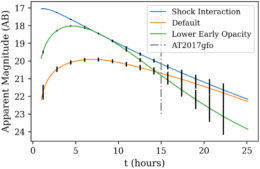Astronomers are still debating the origin of the blue-tinted emission from colliding neutron stars detected in 2017. Stymied by missing data from the crucial first few hours of that event, researchers have determined just how quickly we’ll need to catch the next one.
A Groundbreaking Event

Observed (symbols) and modeled (lines) light curves for AT2017gfo, the electromagnetic counterpart to the gravitational wave signal GW170817. [Adapted from Cowperthwaite et al. 2017]
These observations revealed bright but rapidly fading emission at blue wavelengths in the first day after the collision was detected. Though scientists have proposed many causes for this early blue emission, two theories have risen to the top: radioactive decay of newly fused elements and heating from a shock wave. Researchers suspect that in order to distinguish between these theories, we need ultraviolet data from the first few hours after the merger is detected. We missed those critical data in 2017, with ultraviolet observations beginning 15 hours after detection — how can we ensure we capture them in the future?
When Theories Collide
Bas Dorsman (University of Amsterdam) and collaborators proposed that an ultraviolet satellite with a wide field of view could capture the necessary data next time around. To test this possibility, the team modeled the emission from an AT2017gfo–like collision of two neutron stars, finding that both theories produce ultraviolet emission that matches observations at 15 hours after the event was detected but diverges at earlier times.

Simulated ultraviolet light curves for an AT2017gfo–like neutron star merger. The orange and green lines show the results for two versions of the radioactive decay model, the blue line shows the output from the shock heating model, and the gray line shows the time at which the ultraviolet observations of AT2017gfo began. [Dorsman et al. 2023]
Awaiting Spacecraft
While the team’s results show the promise of collecting early ultraviolet data, we’ll need to wait at least a few years to put the plan into practice. The Dorado spacecraft described in this work didn’t proceed beyond a concept study, but there are two similar spacecraft farther along in the selection process: the Ultraviolet Transient Astronomy Satellite (ULTRASAT; launch planned for 2026) and the Ultraviolet Explorer (UVEX; launch in 2027 or later, if selected).
These missions should overlap with the fifth observing run for the LIGO, Virgo, and KAGRA gravitational wave observatories, which is slated to begin in 2027. Hopefully — a decade after the detection of AT2017gfo — we’ll be able to get some answers!
Citation
“Prospects of Gravitational-wave Follow-up through a Wide-field Ultraviolet Satellite: A Dorado Case Study,” Bas Dorsman et al 2023 ApJ 944 126. doi:10.3847/1538-4357/acaa9e
